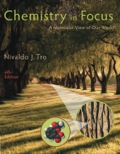
Interpretation:
The four types of contaminants that are found in water with two examples each are to be listed.
Concept Introduction:
Water is a common liquid that is present on the Earth.
It is also known as universal solvent. It can dissolve a wide range of organic and inorganic solutes.
Water is vital for the existence of all living animals. Without water, no life form can exist, it constitutes an important part of rivers, lakes, streams, clouds, snow and ice.
Water is truly an unusual molecule such that being a low molar mass compound, it exists as a liquid at room temperature and has an anonymously high boiling point.
Ice floats on water because it has a lower density than water.
Water contains some unwanted particles which can lead to diseases and other hostile effects on human health.
Water acts as a good solvent, so numerous particles and microbes can contaminate water.
Biological contaminants: Some microbes can live in water and can cause various diseases like cholera, dysentery, and so on. Two examples of such microbes are Giardia and Legionella.
Inorganic contaminants: Some inorganic molecules can dissolve in water and make it impotable (not suited for drinking). Two examples of such molecules are Nitrates and Asbestos.
Organic contaminants: Some organic molecules can dissolve in water and makes it impotable (not suited for drinking). Two examples of such molecules are chlorohydrocarbons (volatile) and ethylbenzene (non-volatile).
Radioactive contaminants: Some radioactive elements can dissolve in water and make it impotable (not suited for drinking). Two examples of such elements are Uranium and Radium.
Want to see the full answer?
Check out a sample textbook solution
Chapter 12 Solutions
Chemistry In Focus
- (SE EX 2) Problems can you please explain them to me in detail and color-code anything if necessary?arrow_forward(SE EX 2) Problems 4-7, can you please explain them to me in detail and color-code anything if necessary?arrow_forwardCan you explain problems 20 - 25 on here (step by step) and in detail for me pleasearrow_forward
- (ME EX2) Can you please explain problems to me in detail, step by step? Thank you so much! If needed color code them for me.arrow_forward(ME EX2) Problems Could you please explain problems to me in detail, step by step? Thank you so much! If necessary, please color-code them for me.arrow_forward(SE EX2) Prblms #1-3: Can you please explain in detail if needed color code them for the three different problems.arrow_forward
- (ME EX2) Problems Could you please explain problems to me in detail, step by step? Thank you so much! If necessary, please color-code them for me.arrow_forward(ME EX2) Prblms 15-16 Can you please explain problems 15-16 to me in detail, step by step? Thank you so much! If needed color code them for me.arrow_forwardMechanism acid catalysed reaction of 3-pentanone with methylamine and dimethylaminearrow_forward
- (ME EX2) Prblms 1-4 Can you please explain problems 1-4 to me in detail, step by step? Thank you so much! If needed color code them for me.arrow_forwardCan you explain the following step by step (in detail) problems 30 - 33 for me please.arrow_forwardDon't used hand raiting and don't used Ai solutionarrow_forward

 Chemistry: The Molecular ScienceChemistryISBN:9781285199047Author:John W. Moore, Conrad L. StanitskiPublisher:Cengage Learning
Chemistry: The Molecular ScienceChemistryISBN:9781285199047Author:John W. Moore, Conrad L. StanitskiPublisher:Cengage Learning Chemistry for Today: General, Organic, and Bioche...ChemistryISBN:9781305960060Author:Spencer L. Seager, Michael R. Slabaugh, Maren S. HansenPublisher:Cengage Learning
Chemistry for Today: General, Organic, and Bioche...ChemistryISBN:9781305960060Author:Spencer L. Seager, Michael R. Slabaugh, Maren S. HansenPublisher:Cengage Learning Chemistry: Principles and ReactionsChemistryISBN:9781305079373Author:William L. Masterton, Cecile N. HurleyPublisher:Cengage Learning
Chemistry: Principles and ReactionsChemistryISBN:9781305079373Author:William L. Masterton, Cecile N. HurleyPublisher:Cengage Learning Introductory Chemistry: A FoundationChemistryISBN:9781337399425Author:Steven S. Zumdahl, Donald J. DeCostePublisher:Cengage Learning
Introductory Chemistry: A FoundationChemistryISBN:9781337399425Author:Steven S. Zumdahl, Donald J. DeCostePublisher:Cengage Learning




